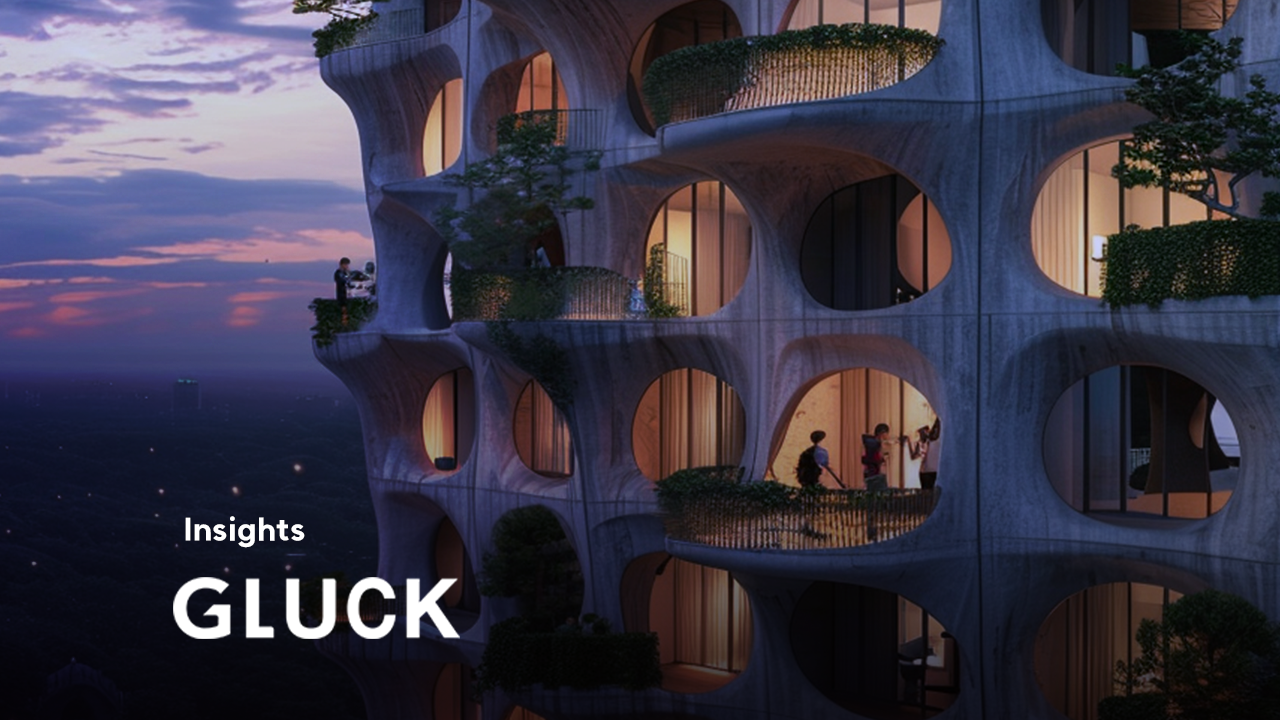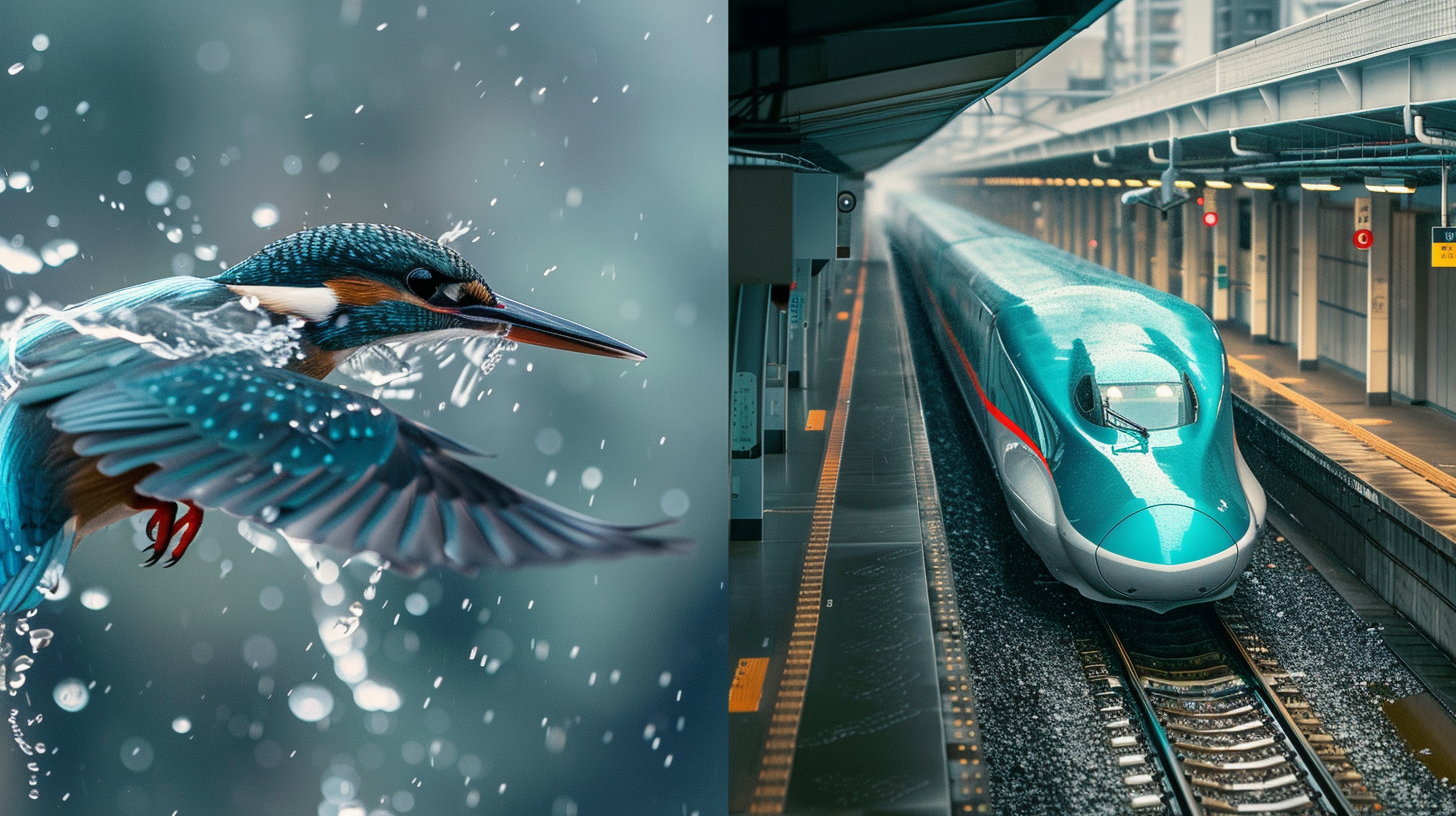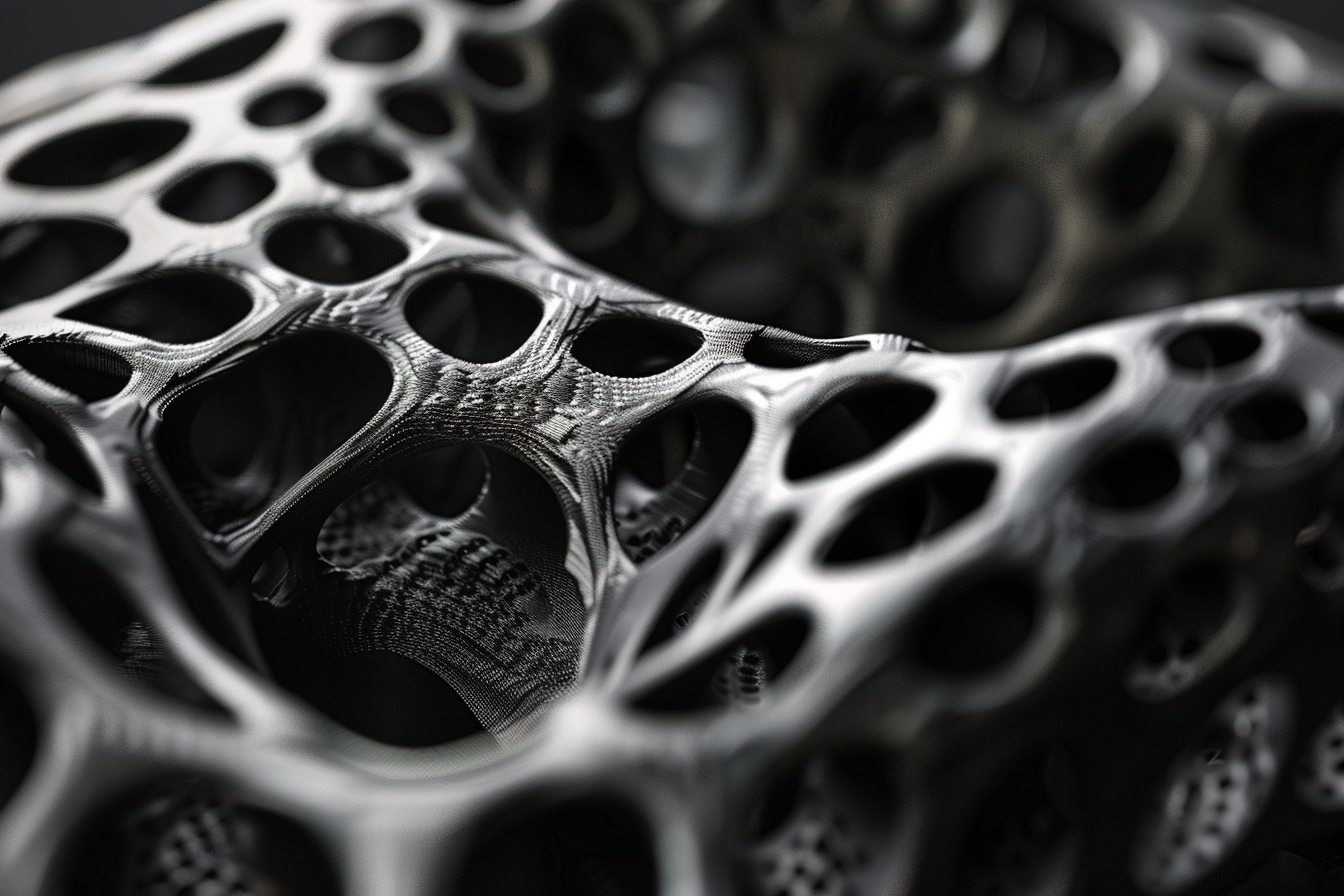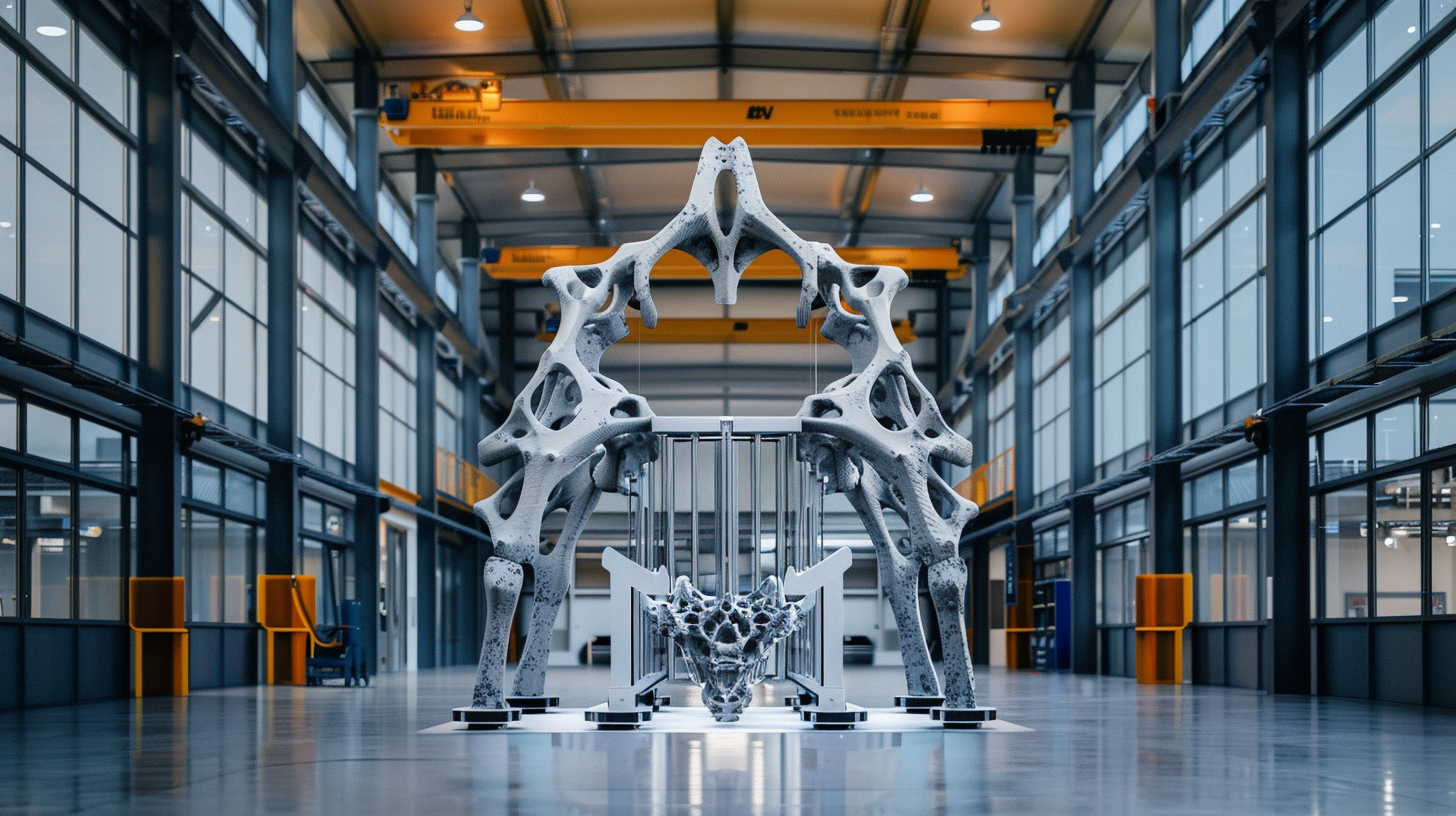
자연은 38억 년이라는 시간 동안 수많은 시행착오를 거쳐 가장 효율적이고 지속 가능한 시스템을 완성해 냈습니다. 생체모방설계(Biomimetic Design)는 바로 이 자연의 오랜 지혜에서 영감을 얻어 인류의 복잡한 문제를 해결하는 혁신적인 접근 방식입니다. 흰개미집의 냉각 시스템에서 에너지 효율적인 건물을 설계하고, 상어 피부에서 항공기의 연료 효율을 높이는 아이디어를 얻는 것이 그 대표적인 예입니다.
하지만 자연이 만든 구조는 인간의 전통적인 제조 방식으로는 구현이 불가능할 정도로 복잡하고 정교합니다. 바로 이 지점에서, 산업용 3D프린팅(적층 제조) 기술이 생체모방설계의 잠재력을 현실로 만드는 핵심적인 역할을 수행합니다. 이 글에서는 생체모방설계의 핵심 원리를 살펴보고, 글룩이 보유한 산업용 3D프린팅 기술이 어떻게 자연의 설계를 현실의 혁신으로 구현해 내는지 구체적인 사례와 함께 알아보겠습니다.
생체모방설계의 핵심: 형태가 아닌 기능을 모방하다

생체모방설계는 단순히 자연의 외형을 모방하는 ‘자연모사(Nature-Inspired)’를 넘어, 자연이 특정 **기능(Function)**을 어떻게 수행하는지를 분석하고 그 근본 원리를 모방하는 데 중점을 둡니다. 이는 외형을 복제하는 것이 아니라, 수십억 년간 진화하며 최적화된 자연의 문제 해결 방식을 배우는 기능 중심적 설계 철학입니다.
- 기능 중심적 접근: 딱딱한 뼈의 내부가 다공성 격자 구조로 이루어져 최소한의 무게로 최대의 강도를 내는 것처럼, 생체모방은 ‘왜’ 그런 형태가 되었는지를 탐구합니다.
- 지속 가능성 지향: 자연은 폐기물 없이 모든 것을 재활용하고 최소한의 에너지로 작동합니다. 생체모방은 이러한 자연의 순환 시스템을 반영하여 환경 친화적인 솔루션을 지향합니다.
- 시스템적 사고: 개별 생물뿐만 아니라 생태계 전체의 상호작용과 균형을 이해하고 이를 디자인에 통합하여 더 큰 차원의 최적화를 추구합니다.
이처럼 기능과 효율, 지속 가능성을 목표로 하는 생체모방설계의 복잡하고 유기적인 아이디어는, 산업용 3D프린팅이라는 혁신적인 제조 기술을 만났을 때 비로소 그 잠재력을 온전히 발휘할 수 있습니다.
산업용 3D프린팅, 자연의 설계를 현실로 만드는 기술

산업용 3D프린팅은 기존 제조 방식의 한계를 뛰어넘어, 자연의 정교하고 다층적인 구조를 현실에 구현하는 독보적인 이점을 제공합니다.
1. 복잡한 기하학적 구조의 정밀한 구현 자연계의 구조물은 내부에 복잡한 격자 구조(Lattice), 속이 빈 중공 코어, 미세 유체 채널 등을 포함하는 경우가 많습니다. 뼈의 해면골 구조나 진주의 나노 스케일 층상 구조가 그 예입니다. 산업용 3D프린팅은 이러한 구조를 단 한 번의 공정으로 정밀하게 적층하여, 자연의 최적화된 설계를 고도의 충실도로 재현합니다. 이는 단순한 외형 모사가 아닌, 기능 중심의 실질적인 성능 향상을 가능하게 합니다.
2. 맞춤형 제작 및 유연한 설계 변경 산업용 3D프린팅은 디지털(CAD) 데이터를 기반으로 하므로, 환자 맞춤형 보철물이나 특정 환경에 최적화된 구조물처럼 고도로 개인화된 설계의 신속한 제작이 가능합니다. 기존 방식에서는 설계 변경 시 금형을 다시 제작해야 하는 막대한 시간과 비용이 발생했지만, 3D프린팅은 디지털 설계만 수정하면 즉시 반영하여 다시 출력할 수 있습니다. 이는 생체모방설계에서 요구되는 반복적인 실험과 최적화 과정을 효과적으로 지원합니다.
3. 생산 시간 단축 및 비용 효율성 소량 생산이나 복잡한 부품 제작 시 금형 없이 직접 출력이 가능하므로, 초기 개발 비용과 시간을 대폭 절감할 수 있습니다. 이는 다양한 생체모방 콘셉트를 빠르게 검증하고 상용화 가능성을 타진하는 데 매우 효과적입니다.
산업 현장에서 피어나는 생체모방 3D프린팅 사례

산업용 3D프린팅과 생체모방설계의 융합은 다양한 산업 분야에서 전례 없는 혁신을 창출하고 있습니다.
- 의료 및 생체공학: 골 조직 공학은 가장 대표적인 성공 사례입니다. 뼈의 해면골 구조가 가진 다공성 네트워크는 영양분 수송과 기계적 강도에 최적화되어 있습니다. 연구자들은 연꽃 씨앗 꼬투리, 벌집 등 자연의 다공성 구조에서 영감을 얻어, 3D프린팅을 통해 뼈 조직의 미세 환경을 정밀하게 모방하는 스캐폴드(Scaffold, 지지체)를 제작하고 있습니다. 이는 골 형성, 혈관 신생을 촉진하며 환자 맞춤형 임플란트 및 인공 장기 개발의 새로운 가능성을 열고 있습니다.
- 항공우주 및 자동차: 경량화와 공기역학적 효율성이 무엇보다 중요한 이 분야에서 생체모방은 핵심적인 역할을 합니다. 에어버스(Airbus)는 뼈의 세포 구조와 성장 원리를 모방하여 3D프린팅으로 더 가볍고 강한 항공기 칸막이를 제작했습니다. 또한 상어 피부의 미세 돌기를 모방한 표면(Riblets)은 항공기의 항력을 감소시켜 연료 효율을 크게 향상시킵니다.
- 건축 및 건설: 짐바б웨의 이스트게이트 센터는 아프리카 흰개미집의 자연 냉각 시스템을 모방하여, 에어컨 없이도 안정적인 실내 온도를 유지합니다. 미래에는 3D프린팅 기술을 통해 이러한 복잡한 공기 순환 구조를 가진 지속 가능한 건축물을 더욱 빠르고 경제적으로 구현할 수 있을 것입니다.
미래 전망: AI와 융합된 진화적 설계

생체모방 3D프린팅의 미래는 인공지능(AI) 및 생성적 설계(Generative Design)와의 통합에 달려있습니다. 생성적 설계는 재료 효율성, 구조 강도 등 특정 매개변수를 기반으로 수많은 디자인 변형을 AI가 자동으로 생성하는 알고리즘적 프로세스입니다.
이는 자연의 진화 원리를 컴퓨터 시뮬레이션으로 구현하는 것과 같습니다. AI가 인간이 상상하기 어려운 최적의 유기적 형태를 탐색하고, 산업용 3D프린팅은 그 복잡한 설계를 현실로 구현하는 거의 유일한 제조 기술입니다. 이러한 융합은 설계 프로세스를 자동화하고, 3D프린팅 공정의 효율성과 품질을 비약적으로 향상시킬 것입니다.
자연의 지혜를 현실로 만드는 기술 파트너

산업용 3D프린팅을 활용한 생체모방설계는 인류가 직면한 복잡한 문제에 대한 지속 가능하고 혁신적인 해결책을 제공하는 강력한 패러다임입니다. 3D프린팅은 단순한 제조 도구를 넘어, 이전에는 상상에 머물렀던 자연의 천재적인 디자인을 현실 세계에 구현하는 핵심적인 기술입니다.
물론 재료의 한계, 프린팅 속도, 높은 비용 등 아직 극복해야 할 과제는 남아있습니다. 그러나 글룩은 최첨단 산업용 3D프린팅 인프라와 깊이 있는 기술 전문성을 바탕으로, 이러한 도전을 해결하고 자연의 지혜와 첨단 제조 기술을 결합하는 데 앞장서고 있습니다. 자연이 설계하고, 글룩이 출력하는 지속 가능한 미래를 함께 만들어 가겠습니다.
GLUCK은 대량생산이 가능한 산업용 3D프린팅 서비스 기업입니다. 작은 아이디어를 반복 가능한 생산성으로 전환해, 현실 가능한 제조 솔루션을 제공합니다.
지금 글룩에 문의해 보세요.
📩 제작 및 상담 문의: https://glucklab.com/

Innovation Inspired by Nature, Printed by 3D Technology: Outputting the Future of Biomimetic Design
For 3.8 billion years, nature has perfected the most efficient and sustainable systems through countless trials and errors. Biomimetic Design is an innovative approach that draws inspiration from these optimized forms, processes, and systems perfected by nature's long evolution to solve complex human problems. Designing energy-efficient buildings from the cooling systems of termite mounds and getting ideas for improving aircraft fuel efficiency from shark skin are prime examples.
However, the structures created by nature are often too complex and sophisticated to be realized with traditional human manufacturing methods. It is at this very point that industrial 3D printing (Additive Manufacturing) technology plays a pivotal role in turning the potential of biomimetic design into reality. This article will explore the core principles of biomimetic design and, with specific examples, look at how GLUCK's industrial 3D printing technology is materializing nature's designs into real-world innovations.
The Core of Biomimetic Design: Mimicking Function, Not Form

Biomimetic design goes beyond merely mimicking nature's appearance—'Nature-Inspired' design—and focuses on analyzing how nature performs a specific Function and emulating its fundamental principles. This is a function-centric design philosophy that seeks to learn from nature's problem-solving methods, which have been optimized over billions of years of evolution.
- Function-Centric Approach: Just as the porous internal lattice structure of a rigid bone provides maximum strength with minimum weight, biomimicry investigates 'why' such a form came to be.
- Sustainability-Oriented: Nature recycles everything without waste and operates on minimal energy. Biomimicry reflects these natural circulatory systems to aim for environmentally friendly solutions.
- Systems Thinking: It seeks to understand not just individual organisms but the interactions and balance of the entire ecosystem and integrate this understanding into the design for a higher level of optimization.
The complex and organic ideas of biomimetic design, which aim for functionality, efficiency, and sustainability, can only fully unleash their potential when combined with the innovative manufacturing technology of industrial 3D printing.
Industrial 3D Printing: The Technology That Makes Nature's Designs a Reality

Industrial 3D printing offers unique advantages that overcome the limitations of traditional manufacturing methods, enabling the realization of nature's sophisticated and multi-layered structures.
1. Precise Realization of Complex Geometries The structures of the natural world often include complex internal lattices, hollow cores, and microfluidic channels. Examples include the trabecular structure of bone or the nanoscale layered structure of pearls. Industrial 3D printing precisely builds up these structures in a single process, reproducing nature's optimized designs with high fidelity. This enables a real performance improvement based on function, not just a simple imitation of form.
2. Customization and Flexible Design Iteration Being based on digital (CAD) data, industrial 3D printing allows for the rapid fabrication of highly personalized designs, such as patient-specific prosthetics or structures optimized for a particular environment. While traditional methods require costly and time-consuming re-molding for any design change, 3D printing can immediately reflect modifications by simply editing the digital file. This effectively supports the iterative experimentation and optimization required in biomimetic design.
3. Reduced Production Time and Cost-Effectiveness For small-batch production or complex parts, direct printing without molds dramatically reduces initial development costs and time. This is highly effective for quickly validating various biomimetic concepts and assessing their commercial viability.
Biomimetic 3D Printing Cases Blossoming in Industrial Fields

The fusion of industrial 3D printing and biomimetic design is creating unprecedented innovation across various industrial sectors.
- Medical and Bioengineering: Tissue engineering is a prime success story. The porous network of trabecular bone is optimized for nutrient transport and mechanical strength. Inspired by porous structures in nature like lotus seed pods and honeycombs, researchers are using 3D printing to precisely mimic the microenvironment of bone tissue to create scaffolds. This is opening new possibilities for promoting bone formation and angiogenesis, as well as for developing patient-specific implants and artificial organs.
- Aerospace and Automotive: In these fields where lightweighting and aerodynamic efficiency are paramount, biomimicry plays a key role. Airbus has used 3D printing to create lighter and stronger aircraft partitions by mimicking the cellular structure and growth principles of bone. Additionally, surfaces that mimic the micro-denticles of shark skin (Riblets) have significantly improved fuel efficiency by reducing drag on aircraft.
- Architecture and Construction: The Eastgate Centre in Zimbabwe mimics the natural cooling system of African termite mounds to maintain a stable indoor temperature without air conditioning. In the future, 3D printing technology will enable the faster and more economical construction of such sustainable buildings with complex air circulation structures.
Future Outlook: The Fusion with AI and Evolutionary Design

The future of biomimetic 3D printing lies in its integration with Artificial Intelligence (AI) and Generative Design. Generative design is an algorithmic process where an AI automatically creates numerous design variations based on specific parameters like material efficiency and structural strength.
This is like implementing the principles of natural evolution in a computer simulation. The AI explores optimal organic forms that a human might not imagine, and industrial 3D printing is virtually the only manufacturing technology capable of realizing these complex designs. This fusion will automate the design process and dramatically improve the efficiency and quality of the 3D printing process.
Conclusion: The Technology Partner That Turns Nature's Wisdom into Reality

Biomimetic design, powered by industrial 3D printing, presents a powerful paradigm for providing sustainable and innovative solutions to the complex problems humanity faces. 3D printing is more than just a manufacturing tool; it is the key enabling technology that brings the ingenious designs of nature, previously confined to imagination, into the real world.
Of course, challenges such as material limitations, printing speed, and high costs still need to be overcome. However, GLUCK, with its state-of-the-art industrial 3D printing infrastructure and deep technical expertise, is at the forefront of combining nature's wisdom with advanced manufacturing technology. We will create a sustainable future together—designed by nature, printed by GLUCK.
GLUCK is an industrial 3D printing service company capable of mass production. We transform small ideas into repeatable productivity, providing realistic manufacturing solutions.
Contact GLUCK today.
📩 For production and consultation inquiries: https://glucklab.com/
#GLUCK #글룩 #3D프린팅 #산업용3D프린팅 #SLA3D프린팅 #대량생산 #DfAM #3D설계 #3D프린팅산업 #3D프린터 #3D모델링 #3D프린팅가격 #3D프린팅업체 #금형제작 #금형 #사출 #몰드제작 #3D프린팅견적 #3D출력 #MassProduction #3DPrinting #LargescaleProduction #AdditiveManufacturing #SLAtechnology #ManufacturingInnovation #DigitalTransformation #SmartManufacturing #생체모방 #생체모방설계 #자연모사 #제너레이티브디자인 #바이오미미크리 #Biomimicry #BiomimeticDesign #NatureInspired #GenerativeDesign #Bionics
'인사이트 (Insights)' 카테고리의 다른 글
| 3D프린팅 기반 조명 제조 전략, 설계 유연성과 생산 효율을 동시에! (1) | 2025.09.19 |
|---|---|
| 3D프린팅 부품의 인체 적용에 관한 규제, 인증, 그리고 제조 산업 (0) | 2025.09.19 |
| 특별한 순간을 위한 맞춤 트로피, 산업용 SLA 3D프린팅의 힘 (0) | 2025.09.18 |
| 3D프린팅, 예술의 새로운 캔버스: 기술이 빚어내는 창작의 혁신 (0) | 2025.09.17 |
| 무게는 줄이고 강도는 높이는 기술 : 산업용 3D프린팅 경량화 설계 (0) | 2025.09.16 |
